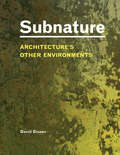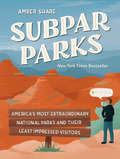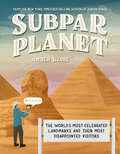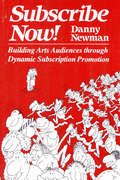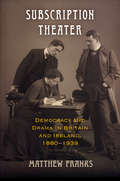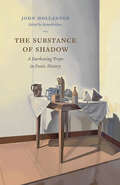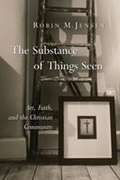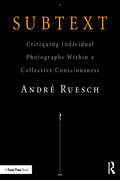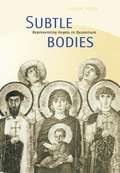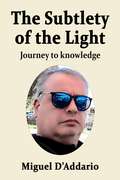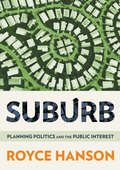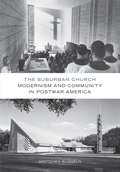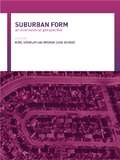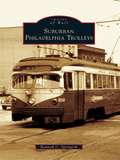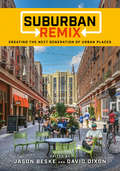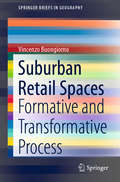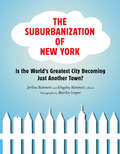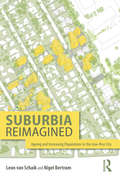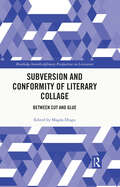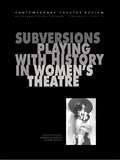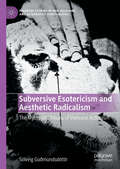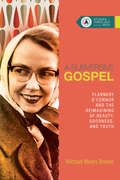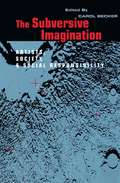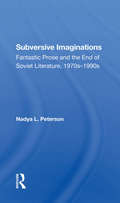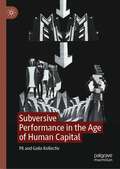- Table View
- List View
Subnature: Architecture's Other Environments
by David GissenWe are conditioned over time to regard environmental forces such as dust, mud, gas, smoke, debris, weeds, and insects as inimical to architecture. Much of today's discussion about sustainable and green design revolves around efforts to clean or filter out these primitive elements. While mostly the direct result of human habitation, these 'subnatural forces' are nothing new. In fact, our ability to manage these forces has long defined the limits of civilized life. From its origins, architecture has been engaged in both fighting and embracing these so-called destructive forces. In Subnature, David Gissen, author of our critically acclaimed Big and Green, examines experimental work by today's leading designers, scholars, philosophers, and biologists that rejects the idea that humans can somehow recreate a purely natural world, free of the untidy elements that actually constitute nature. Each chapter provides an examination of a particular form of subnature and its actualization in contemporary design practice.The exhilarating and at times unsettling work featured in Subnature suggests an alternative view of natural processes and ecosystems and their relationships to human society and architecture. R&Sie(n)'s Mosquito Bottleneck house in Trinidad uses a skin that actually attracts mosquitoes and moves them through the building, while keeping them separate from the occupants. In his building designs the architect Philippe Rahm draws the dank air from the earth and the gasses and moisture from our breath to define new forms of spatial experience. In his Underground House, Mollier House, and Omnisport Hall, Rahm forces us to consider the odor of soil and the emissions from our body as the natural context of a future architecture. [Cero 9]'s design for the Magic Mountain captures excess heat emitted from a power generator in Ames, Iowa, to fuel a rose garden that embellishes the industrial site and creates a natural mountain rising above the city's skyline. Subnature looks beyond LEED ratings, green roofs, and solar panels toward a progressive architecture based on a radical new conception of nature.
Subpar Parks: America's Most Extraordinary National Parks and Their Least Impressed Visitors
by Amber Share**A New York Times Bestseller!** Based on the wildly popular Instagram account, Subpar Parks features both the greatest hits and brand-new content, all celebrating the incredible beauty and variety of America&’s national parks juxtaposed with the clueless and hilarious one-star reviews posted by visitors. Subpar Parks, both on the popular Instagram page and in this humorous, informative, and collectible book, combines two things that seem like they might not work together yet somehow harmonize perfectly: beautiful illustrations and informative, amusing text celebrating each national park paired with the one-star reviews disappointed tourists have left online. Millions of visitors each year enjoy Glacier National Park, but for one visitor, it was simply "Too cold for me!" Another saw the mind-boggling vistas of Bryce Canyon as "Too spiky!" Never mind the person who visited the thermal pools at Yellowstone National Park and left thinking, &“Save yourself some money, boil some water at home.&” Featuring more than 50 percent new material, the book will include more depth and insight into the most popular parks, such as Yosemite, Yellowstone, the Grand Canyon, and Acadia National Parks; anecdotes and tips from rangers; and much more about author Amber Share's personal love and connection to the outdoors. Equal parts humor and love for the national parks and the great outdoors, it's the perfect gift for anyone who loves to spend time outside as well as have a good read (and laugh) once they come indoors.
Subpar Planet: The World's Most Celebrated Landmarks and Their Most Disappointed Visitors
by Amber ShareNew York Times bestselling author and illustrator of Subpar Parks Amber Share takes us around the globe to celebrate the world&’s greatest wonders alongside hysterical reviews from their harshest critics.The world is filled with marvels—both natural and human-made— and artist Amber Share has made it her mission to capture the unique majesty of these sites alongside reactions from some of their most vocal visitors. The Dead Sea? &“Who needs burning eyes?&” Who indeed? Big Ben? &“Just a really big clock.&” Go figure. With Share's classic spin on visitors&’ candidly cranky reviews of each location, Subpar Planet fills skeptical travelers with a wanderlust for the world's most spectacular features, including the Eiffel Tower, the Taj Mahal, the Great Barrier Reef, Chichén Itzá, the Sahara, and many more! Equal parts hilarious and informative, Subpar Planet is perfect for seasoned globe-trotters, people interested in broadening their worldly horizons, and anyone who simply wants to see the unique ways their fellow human beings interact with the world around them.
Subscribe Now!
by Danny Newman"Buy it, borrow it, steal it, but get your hands on it! If you follow Danny's advice on how to sell tickets, you won't have an unsold seat in the house all season long!"--Ralph Black, American Symphony League
Subscription Theater: Democracy and Drama in Britain and Ireland, 1880-1939 (Material Texts)
by Matthew FranksSubscription Theater asks why turn-of-the-century British and Irish citizens spent so much time, money, and effort adding their names to subscription lists. Shining a spotlight on private play-producing clubs, public repertory theaters, amateur drama groups, and theatrical magazines, Matthew Franks locates subscription theaters in a vast constellation of civic subscription initiatives, ranging from voluntary schools and workers' hospitals to soldiers' memorials and Diamond Jubilee funds. Across these enterprises, Franks argues, subscribers created their own spaces for performing social roles from which they had long been excluded. Whether by undermining the authority of the Lord Chamberlain's Examiner of Plays and London's commercial theater producers, or by extending rights to disenfranchised women and property-less men, a diverse cast of subscribers including typists, plumbers, and maids acted as political representatives for their fellow citizens, both inside the theater and far beyond it. Citizens prized a "democratic" or "representative" subscription list as an end in itself, and such lists set the stage for the eventual public subsidy of subscription endeavors.Subscription Theater points to the importance of printed ephemera such as programs, tickets, and prospectuses in questioning any assumption that theatrical collectivity is confined to the live performance event. Drawing on new media as well as old, Franks uses a database of over 23,000 stage productions to reveal that subscribers introduced nearly a third of the plays that were most frequently revived between 1890 and the mid-twentieth century, as well as nearly half of all new translations, and they were instrumental in staging the work of such writers as Shaw and Ibsen, whose plays featured subscription lists as a plot point or prop. Although subscribers often are blamed for being a conservative force in theater, Franks demonstrates that they have been responsible for how we value audience and repertoire today, and their history offers a new account of the relationship between ephemera, drama, and democracy.
The Substance of Shadow: A Darkening Trope in Poetic History
by John Hollander Kenneth GrossJohn Hollander, poet and scholar, was a master whose work joined luminous learning and imaginative risk. This book, based on the unpublished Clark Lectures Hollander delivered in 1999 at Cambridge University, witnesses his power to shift the horizons of our thinking, as he traces the history of shadow in British and American poetry from the Renaissance to the end of the twentieth century. Shadow shows itself here in myriad literary identities, revealing its force as a way of seeing and a form of knowing, as material for fable and parable. Taking up a vast range of texts--from the Bible, Dante, Shakespeare, and Milton to Poe, Dickinson, Eliot, and Stevens--Hollander describes how metaphors of shadow influence our ideas of dreaming, desire, doubt, and death. These shadows of poetry and prose fiction point to unknown, often fearful domains of human experience, showing us concealed shapes of truth and possibility. Crucially, Hollander explores how shadows in poetic history become things with a strange substance and life of their own: they acquire the power to console, haunt, stalk, wander, threaten, command, and destroy. Shadow speaks, even sings, revealing to us the lost as much as the hidden self. An extraordinary blend of literary analysis and speculative thought, Hollander's account of the substance of shadow lays bare the substance of poetry itself.
The Substance of Things Seen: Art, Faith, and the Christian Community (Calvin Institute of Christian Worship Liturgical Studies)
by Robin JensenWhile the average person rarely sees it, the visual arts play a subtle yet profound role in the teaching and formation of faith, both for individuals and religious communities. The Substance of Things Seen explores the intersection of art and faith, offering thoughtful reflections on the way art functions in Christian life and practice. <p><p> Highly readable and featuring instructive illustrations, this book is meant to engage church leaders as well as artists in constructive conversation about the critical role that art can play in the renewal of Christian education, worship, and study. It also challenges anyone who thinks the arts are only of marginal importance to the religious life. Robin Jensen considers here a broad range of topics relevant to Christian faith and culture, including the construction of sacred space, the use of art in worship and spiritual formation, the way that visual art interprets sacred texts, and the power and danger of art from a historical and contemporary perspective.
Subtext: Critiquing Individual Photographs within a Collective Consciousness
by Andre RueschSubtext invites and encourages personal and blatantly subjective responses to photographs and analyzes the drivers behind them. During decades of participating in critiques as both student and teacher, André Ruesch has become convinced that it is the personal response to work that connects us in the most visceral and meaningful way. This book aims to encourage and educate viewers how to read and understand photographs on a deeper level, honoring and validating their responses to photographs. This book seeks to vitalize students in the photography classroom. Rather than a dense tome of theory, this is an accessible guide to taking individual ownership of—and enjoying—the visual experience. To be visually literate is comparable to being linguistically literate. Such literacy is necessary to engender a deeper understanding and valuation of culture: both types of literacy create, enrich, define and historically document the expression of one individual to be shared by all.
Subtle Bodies: Representing Angels in Byzantium
by Glenn PeersHow Byzantine artists approached the problem of representing the incorporeal, immaterial forms and inscrutable natures of angels.
The Subtlety of the Light: Journey to knowledge
by Miguel D'AddarioThe Subtlety of the Light is a book that summarizes a number of writings related to philosophical, altruistic, metaphysical and existentialist thoughts. It is approached through poetic forms, essays or profound testaments. Based on schools of existential knowledge and currents that analyze the presence of man on earth. To analyze and reflect, understand and conclude.
Suburb: Planning Politics and the Public Interest
by Royce HansonLand-use policy is at the center of suburban political economies because everything has to happen somewhere but nothing happens by itself. In Suburb, Royce Hanson explores how well a century of strategic land-use decisions served the public interest in Montgomery County, Maryland, a suburb of Washington, D.C. Transformed from a rural hinterland into the home a million people and a half-million jobs, Montgomery County built a national reputation for innovation in land use policy—including inclusive zoning, linking zoning to master plans, preservation of farmland and open space, growth management, and transit-oriented development.A pervasive theme of Suburb involves the struggle for influence over land use policy between two virtual suburban republics. Developers, their business allies, and sympathetic officials sought a virtuous cycle of market-guided growth in which land was a commodity and residents were customers who voted with their feet. Homeowners, environmentalists, and their allies saw themselves as citizens and stakeholders with moral claims on the way development occurred and made their wishes known at the ballot box. In a book that will be of particular interest to planning practitioners, attorneys, builders, and civic activists, Hanson evaluates how well the development pattern produced by decades of planning decisions served the public interest.
The Suburban Church: Modernism and Community in Postwar America (Architecture, Landscape and Amer Culture)
by Gretchen BuggelnAfter World War II, America&’s religious denominations spent billions on church architecture as they spread into the suburbs. In this richly illustrated history of midcentury modern churches in the Midwest, Gretchen Buggeln shows how architects and suburban congregations joined forces to work out a vision of how modernist churches might help reinvigorate Protestant worship and community. The result is a fascinating new perspective on postwar architecture, religion, and society.Drawing on the architectural record, church archives, and oral histories, The Suburban Church focuses on collaborations between architects Edward D. Dart, Edward A. Sövik, Charles E. Stade, and seventy-five congregations. By telling the stories behind their modernist churches, the book describes how the buildings both reflected and shaped developments in postwar religion—its ecumenism, optimism, and liturgical innovation, as well as its fears about staying relevant during a time of vast cultural, social, and demographic change.While many scholars have characterized these congregations as &“country club&” churches, The Suburban Church argues that most were earnest, well-intentioned religious communities caught between the desire to serve God and the demands of a suburban milieu in which serving middle-class families required most of their material and spiritual resources.
Suburban Form: An International Perspective
by Kiril Stanilov Brenda Case ScheerThis book examines and documents the remarkable development and transformation of suburban form throughout the globe during the twentieth century. The premise that suburban areas are monotonous, inert environments is put to a test through investigation of the complexity of those suburban settings and the dynamic physical changes that have taken place since their inception.
Suburban Philadelphia Trolleys
by Kenneth C. SpringirthThe Philadelphia Suburban Transportation Company prospered through the hard times of the 1930s and was the last privately-owned trolley system in the United States. Aerodynamically designed Bullet cars of the Philadelphia and Western Railway dramatically reduced travel time on the Sixty-ninth Street toNorristown line. The Presidents' Conference Committee trolley cars of the Philadelphia Transportation Company linked the boroughs of Darby, Colwyn, and Yeadon with Philadelphia. Photographs of Media's 1977 town fair feature vintage trolleys in the only suburban community in the United States with a trolley line ending in its main street. Suburban Philadelphia Trolleys covers the history of the trolleys that served Philadelphia's western suburbs.
Suburban Remix: Creating the Next Generation of Urban Places
by David Dixon Jason BeskeThe suburban dream of a single-family house with a white picket fence no longer describes how most North Americans want to live. The dynamics that powered sprawl have all but disappeared. Instead, new forces are transforming real estate markets, reinforced by new ideas of what constitutes healthy and environmentally responsible living. Investment has flooded back to cities because dense, walkable, mixed-use urban environments offer choices that support diverse dreams. Auto-oriented, single-use suburbs have a hard time competing.Suburban Remix brings together experts in planning, urban design, real estate development, and urban policy to demonstrate how suburbs can use growing demand for urban living to renew their appeal as places to live, work, play, and invest. The case studies and analyses show how compact new urban places are already being created in suburbs to produce health, economic, and environmental benefits, and contribute to solving a growing equity crisis.Above all, Suburban Remix shows that suburbs can evolve and thrive by investing in the methods and approaches used successfully in cities. Whether next-generation suburbs grow from historic village centers (Dublin, Ohio) or emerge de novo in communities with no historic center (Tysons, Virginia), the stage is set for a new chapter of development—suburbs whose proudest feature is not a new mall but a more human-scale feel and form.
Suburban Retail Spaces: Formative and Transformative Process (SpringerBriefs in Geography)
by Vincenzo BuongiornoThis book derives from observations of the contemporary built environment and its contradictions. The suburban retail spaces, specifically the suburban shopping mall, and the changes caused by them within urban organisms are the object of the investigation synthesized in the volume. The topic is very crucial for the development of the contemporary city. It constitutes at the same time a problem (large commercial structures' spread is 'destroying' traditional commercial urban fabrics) and an opportunity (shopping malls are the most vital parts of the new suburbs and can play the role of community nucleus in urban and suburban areas). Furthermore, the spread of e-commerce forces these structures to functional and spatial transformations that brings also a new relationship with the city.The analytical reading, supplemented by generative and design projections, is carried out by using the conceptual and methodological tools of urban morphology, specifically those of the typological processual approach. From this specific point of view, the suburban shopping mall is read as an organism (a complex system characterized by mutual solidarity and interdependence among component elements) in itself, and as a sub-organisms belonging to the largest territorial organism.The book is intended to offer, to operators, scholars, researchers, professionals and students, a reading and design method, to interpret an important aspect of the contemporary built environment by analyzing the suburban commercial space case. It offers at the same time a model applicable to other specific not-commercial cases, to defining paths for further research and design developments.
The Suburbanization of New York: Is the World's Greatest City Becoming Just Another Town?
by Martha Cooper Kingsley Hammett Jerilou HammettThe city that never sleeps also never stops changing. And while New Yorkers are renowned for their trendsetting, this thought-provoking book argues that New York City itself has become a follower rather than a leader. Once-distinctive streets and neighborhoods have become awash in generic stores, apartment boxes, and garish signs and billboards. Legendary neighborhoods (Little Italy, Hell's Kitchen, Harlem, the Lower East Side) have been smoothed over with cute monikers, remade for real-estate investment and for sale to the highest bidder.
Suburbia Reimagined: Ageing and Increasing Populations in the Low-Rise City
by Leon van Schaik Nigel BertramWorldwide, more and more people are living in cities, with suburbs conceived as appendages to the city, rather than being part of the city system, which is densely populated and offers a full range of services. But suburbs are not the city spread too thin, and in fact hold potential for a lived complexity as satisfying as that assumed to be available in inner cities. Just as the ecological function of wetlands was ignored by modernist planning, and swamps once-drained are now recognised as vital to water cycles, suburbs are increasingly recognised as part of a city’s wellbeing with their own alternative ideology and opportunities for urbanity and ecological sustainability. Suburbia Reimagined shows how such subdivision structures can offer new possibilities for sustainably integrating living between generations and between established and arriving migrant communities. The authors worked locally and internationally with university campuses, shopping centres, hospitals, airports, and other large entities spread through suburbia, to identify a broad range of suburban situations that have been modified to ensure that residents have a full access to amenities and services. The book addresses the history and design of suburbia, from the post-war soldier settlements of the 40s and 50s to the university hinterlands of Silicon Valley in order to reappraise the locked potential within such subdivision patterns. The authors propose a new model forward, examining case studies ranging from repurposed malls and railways for ecological sustainability to cul-de-sacs as social units and post-industrial factory conversions, ultimately showing the nascent patterns in suburbia that have the potential to support a rich life for all age groups.
Subversion and Conformity of Literary Collage: Between Cut and Glue (Routledge Interdisciplinary Perspectives on Literature)
by Magda DraguSubversion and Conformity of Literary Collage: Between Cut and Glue fills a gap in the current scholarship on literary collage, by addressing how different the interpretations of the concept are, depending on the author who uses the concept and the material and writers surveyed. The book studies writers who employed literary collage during the twentieth and twenty-first centuries, some whose works have been intensely analyzed from this perspective (William S. Burroughs and Walter Benjamin), but also some whose collage-writing style has recently been investigated by writers, being usually placed under the umbrella term of artist books (Stelio Maria Martini).
Subversions
by Erika Block Gabriele Griffin Julie WilkinsonFirst Published in 1998. Routledge is an imprint of Taylor & Francis, an informa company.
Subversive Esotericism and Aesthetic Radicalism: The Myths and Rituals of Viennese Actionism (Palgrave Studies in New Religions and Alternative Spiritualities)
by Sólveig GuðmundsdóttirIn this book, Sólveig Guðmundsdóttir uncovers the crucial role of esotericism in the art of the Vienna Actionists—a group of Austrian neo-avant-garde artists, infamous for their transgressive performance art. Addressing this frequently overlooked aspect of Actionism, Guðmundsdóttir traces, historicizes, and examines the esoteric discourses in selected works: the collective manifesto Die Blutorgel (1962), Rudolf Schwarzkogler’s text Das Ästhetische Panorama (1967/68) and the performances Abreaktionsspiel (1970) by Hermann Nitsch, and Zerreißprobe (1970) by Günter Brus. Mapping out the various discursive entanglements as they appear in the works, i.e. between esotericism and psychoanalysis, fascism, gender, sexuality, aesthetics, science, orientalism and religious discourses, the author illustrates and establishes the importance of esoteric traditions for the Actionists’ art and subversive practices. The historical analysis of the artworks reflects on the cultural nexus of post-war Austria, as well as the relations between radical politics, countercultures and esotericism, and how they appear in Actionism. Guðmundsdóttir argues that to survey the historical placement of esotericism is vital for understanding not only the context of their works, but also the contradictory image of the Actionists as both anti-authoritarian and reactionary artists.
A Subversive Gospel: Flannery O'Connor and the Reimagining of Beauty, Goodness, and Truth (Studies in Theology and the Arts)
by Michael BrunerThe good news of Jesus Christ is a subversive gospel, and following Jesus is a subversive act. These notions were embodied in the literary work of American author Flannery O'Connor, whose writing was deeply informed by both her Southern context and her Christian faith. In this volume in IVP Academic's Studies in Theology and the Arts series, theologian Michael Bruner explores O'Connor's theological aesthetic and argues that she reveals what discipleship to Christ entails by subverting the traditional understandings of beauty, truth, and goodness through her fiction. In addition, Bruner challenges recent scholarship by exploring the little-known influence of Baron Friedrich von Hügel, a twentieth-century Roman Catholic theologian, on her work. Bruner's study thus serves as a guide for those who enjoy reading O'Connor and—even more so—those who, like O'Connor herself, follow the subversive path of the crucified and risen one.
The Subversive Imagination: The Artist, Society and Social Responsiblity
by Carol BeckerFirst Published in 1994. Routledge is an imprint of Taylor & Francis, an informa company.
Subversive Imaginations: Fantastic Prose And The End Of Soviet Literature, 1970s-1990s
by Nadya PetersonIn response to the profound changes in Soviet society in recent years, the author considers the demise of Soviet literature and the emergence of its Russian progeny through the prism of the writers' engagement with fantasy. Viewing the mutual interaction of Soviet/Russian literary output with aspects of the dominant culture such as ideology and politics, Nadya Peterson traces the process of mainstream literary change in the context of broader social change. She explores the subversive character of the fantastic orientation, its Utopian and apocalyptic motifs, and its dialogical relationship with socialist realism, as it steadily gathered force in the latter Soviet decades. The shattering of the mythic colossus did not put an end to these opposing forces, but rather diverted them in various unexpected directions–as the author explains in her concluding chapters on the new "alternative" literatures.
Subversive Performance in the Age of Human Capital
by Pil Kollectiv Galia KollectivContemporary art relies on an expansionist, modernist ideal and still progresses through a critique of earlier forms of democratisation. But beneath this democratic drive, lurks a creeping crisis. Under neoliberalism, criticality has become a zone of value production. A self-deprecating irony, exposing and re-enacting this position of impotence, is one of the few gestures left in the arsenal of critical art. Against this irony, this book pits overidentification. This term has been taken to mean a kind of parodic mimicry of institutional power. Using a broad tapestry of sources, from political philosophers to art theorists, from post-Marxist critiques of labour to ethnographic studies, it proposes an interpretation of overidentification that does not collapse into ironic posturing. The authors differentiate this from bad faith flirting with taboo aesthetics by focusing on practices grounded in a genuine identification with power that ushers the kind of excess implied by overidentification. It is these forms of overidentification that destabilise the metastasis of liberal-democracy. Staging forms of critique not so readily absorbed into the structure of the present, these subversive performances herald a future beyond the democratic paradox.
